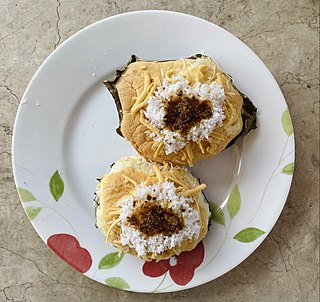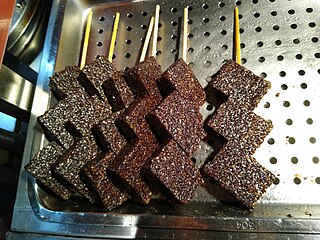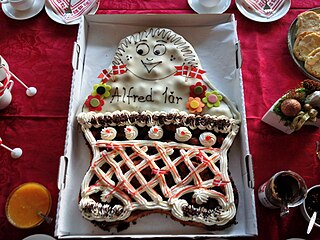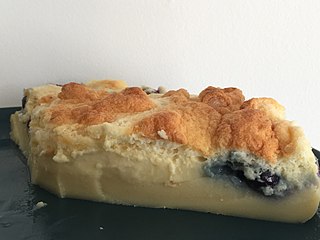
A funeral is a ceremony connected with the final disposition of a corpse, such as a burial or cremation, with the attendant observances. Funerary customs comprise the complex of beliefs and practices used by a culture to remember and respect the dead, from interment, to various monuments, prayers, and rituals undertaken in their honour. Customs vary between cultures and religious groups. Funerals have both normative and legal components. Common secular motivations for funerals include mourning the deceased, celebrating their life, and offering support and sympathy to the bereaved; additionally, funerals may have religious aspects that are intended to help the soul of the deceased reach the afterlife, resurrection or reincarnation.
A sin-eater is a person who consumes a ritual meal in order to spiritually take on the sins of a deceased person. The food was believed to absorb the sins of a recently dead person, thus absolving the soul of the person.

An ice cream cake is a cake made entirely out of ice cream. A simpler no-bake version can be made by layering different flavors of ice cream in a loaf pan.

Bibingka commonly refers to a type of baked rice cake from the Philippines that is traditionally cooked in a terracotta oven lined with banana leaves and is usually eaten for breakfast or as merienda especially during the Christmas season. It is also known as bingka in the Visayas and Mindanao islands.

A rice cake may be any kind of food item made from rice that has been shaped, condensed, or otherwise combined into a single object. A wide variety of rice cakes exist in many different cultures in which rice is eaten. Common variations include cakes made with rice flour, those made from ground rice, and those made from whole grains of rice compressed together or combined with some other binding substance.

Flies' graveyard and flies' cemetery are nicknames used in various parts of the United Kingdom for sweet pastries filled with currants or raisins, which are jokingly said to resemble dead flies. In Scotland, they are known as fly cakes, fruit slice or fruit squares and in Northern Ireland as currant squares. In the North East of England, the pastries are fly cakes or fly pie. In Wales it is called Cacen Pwdin ; and in New Zealand they are known as fruit slice or fly cemetery.
The Lambya, are an ethnic and linguistic group based along the border of northwestern Malawi,Ileje and in Momba District of Mbeya Region, Tanzania. A minority also exists in Zambia. In 2001 the Lambya population was estimated to number 85,000, including 45,000 in Malawi and 40,000 in Tanzania. The Lambya in Malawi are ruled by Senior Chief Mwaulambya Chieftaincy. The headquarters of the chief is in Chinunkha, Chitipa district.

Bánh bèo is a Vietnamese dish that is originated from Huế, a city in Central Vietnam. The English translation for this dish is water fern cakes. Bánh bèo is made from a combination of rice flour and tapioca flour. It is popular street food in Vietnam. The ingredients include rice cake, dried shrimps, crispy pork skin, scallion oil, and dipping sauce. It is usually eaten as a snack but is now considered a dish in restaurants and can be eaten as lunch and dinner.

Pan de Pascua is a Chilean cake traditionally eaten around Christmas time. Although "Pascua" primarily means Passover and secondarily means Easter, it also may mean Christmas and Epiphany. In Chile both Navidad and Pascua are used to refer to Christmas. Despite its name, it is a cake made from batter, and not a true bread. It is similar to a sweet sponge cake flavored with ginger and honey. It usually contains candied fruits, raisins, walnuts and almonds. Pan de Pascua was originally introduced to Chile by German immigrants. The Chilean version combines characteristics of the German Stollen and the Italian Pandoro.

Fa gao, also called fat pan (發粄) by the Hakka, prosperity cake, fortune cake, Cantonese sponge cake, is a Chinese steamed, cupcake-like pastry. Because it is often characterized by a split top when cooked, it is often referred as Chinese smiling steamed cake or blooming flowers. It is commonly consumed on the Chinese new year. It is also eaten on other festivals, wedding, and funerals by the Hakka people.

Kuzumochi (葛餅/久寿餅) is a Japanese term referring either to mochi cakes made of kuzuko (葛粉) or mochi cakes made from Lactobacillales-fermented wheat starch (久寿餅), a speciality dish local to certain wards of Tokyo, served chilled and topped with kuromitsu and kinako.

Kudzu powder, called géfěn (葛粉) in Chinese, kuzuko in Japanese, chik-garu (칡가루) or galbun in Korean, and bột sắn dây in Vietnamese is a starch powder made from the root of the kudzu plant. It is used in traditional East Asian cuisine mainly for thickening sauces and making various types of desserts.

Jewish apple cake is a dense cake made with apples which originated in Poland, but is now sold mostly in the U.S. state of Pennsylvania. Apples are common in Jewish Ashkenazi cooking and are a part of the traditional food served during the Jewish holiday of Rosh Hashanah. Jewish apple cake is traditionally made without dairy products, and may, therefore, be eaten with meals containing meat, in accordance with Jewish dietary laws of kashrut, which forbid the mixing of meat and milk products in the same meal. The use of oil instead of butter also makes this cake a popular choice during Hanukkah, when it is traditional to eat fried or oily foods in remembrance of the miracle of the oil.
Ombusombus is typical Batak food or snacks from Siborong-Borong, North Tapanuli Regency, Indonesia.

Ti hoeh koe, as known as pig's blood cake, is a blood pudding served on a stick as street food in Taiwan. Its alternative name is black cake. It is made with steamed pork blood, sticky rice and then coated in peanut powder and coriander with dipping sauces. Pig's blood cake came from Fujian to Taiwan and then developed. It is eaten as a snack. It can also be cooked in a hot pot. It is served hot by street vendors who keep it warmed in a wooden box or metal steamer. A description from Seriouseats described it as cross between a rice cake and mochi.

Kagemand or Kagekone is a Danish cake in the shape of a boy or a girl whose head is removed, and which is traditionally eaten at birthdays and anniversaries.

A gâteau magique is a French cake that forms three layers when the batter is baked. The bottom layer is custard, the middle layer is cream and the top layer is a sponge.

Formerly in Spain, the pan de ánimas, pan de difunto or pan de muerto were breads that were prepared, blessed and offered to deceased loved ones during All Saints' Day and All Souls' Day.














